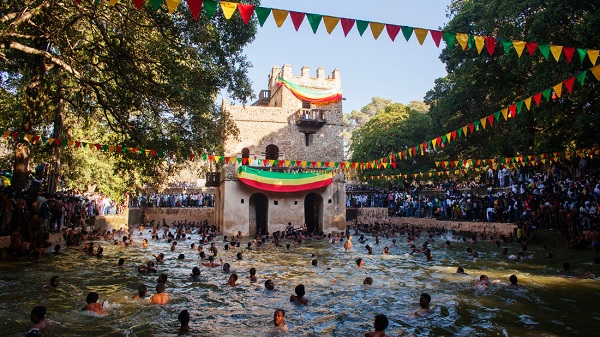
Timket is celebrated every January throughout the country. But many consider Gondar to host the best experience: Its 17th-century pool, surrounding one of the city’s many historical palaces, holds just the right amount of drama and history.
By Diane J. McDougall (Selamta)
I’m fully aware that I don’t blend in. I might be wearing the traditional netela — a gauzy cotton white scarf with a splash of color and pattern along the ends. But at almost 5 feet 10 inches with pale hair, pale eyes and pale skin, I’m fooling no one. I am clearly a ferenji, a foreigner, joining hundreds of other foreigners and thousands of Ethiopians to celebrate the religious festival of Timket in the city of Gondar.
This lively, three-day observance is a study in contrasts: deep solemnity of faith intermixed with exuberance; the stark white of ceremonial dress dotted by flashes of color; ancient ritual captured on smartphones and tablets.
Timket traces its roots back to biblical times. In the early days of Judaism, a sacred box overlaid with gold was kept in the most holy place in the Jewish temple. Known as the Ark of the Covenant, it represented the coming Messiah.
Fast forward to the first millennium, when Jesus of Nazareth was hailed by many as that long-awaited Messiah. His earthly ministry was marked by baptism in the Jordan River. Ever since, Ethiopian Orthodox churches have treasured and closely guarded their own model of the Ark of the Covenant, called a tabot. The tabot only leaves the church during Timket, when it’s carried with great pomp to a nearby pool or river and immersed, along with many of the Christian faithful, in commemoration of Jesus’ baptism.
I’ve traveled to Ethiopia to join in that great pomp.
Timket is celebrated every January throughout the country. But many consider Gondar to host the best experience: Its 17th-century pool, surrounding one of the city’s many historical palaces, holds just the right amount of drama and history.
In Gondar, the three-day affair starts (as it will later end) with smaller ceremonies at eight different churches. Then, eight colorful parades of choirs and priests — accompanied by Gondar’s entire population, it seems — begin blending like a river’s tributaries until they meet at the piazza. Their final destination is Fasiladas’ Bath, about 2 kilometers away.
The procession looks more like a noisy, undulating party, with thousands of people pressed shoulder to shoulder for miles. But it’s a slow party. To the crowded conditions, add the holy, ceremonial laying-down of rugs upon which the priests will step as they carry the tabots.
Each church’s high priest is swathed in colorful robes, with the tabot concealed in more layers of fabric high atop his head. He’s surrounded by other richly clothed priests, all protected from the beating sun by spectacularly embroidered umbrellas. As this huddle moves forward a few steps, young men roll up the rug recently trodden and prepare to dash with it to the front of the procession, to lay it down again. Tag teams of rug-rollers hustle back-and-forth endlessly under a bright sun.
In contrast to the priests’ vestments, most Ethiopians are draped in various layers of white, with threads of color as accent. Those who are clad in multihued holiday finery are mere spots of bright relief in the sea of clean white that spreads before us.
Read the complete story at Selamta Magazine
